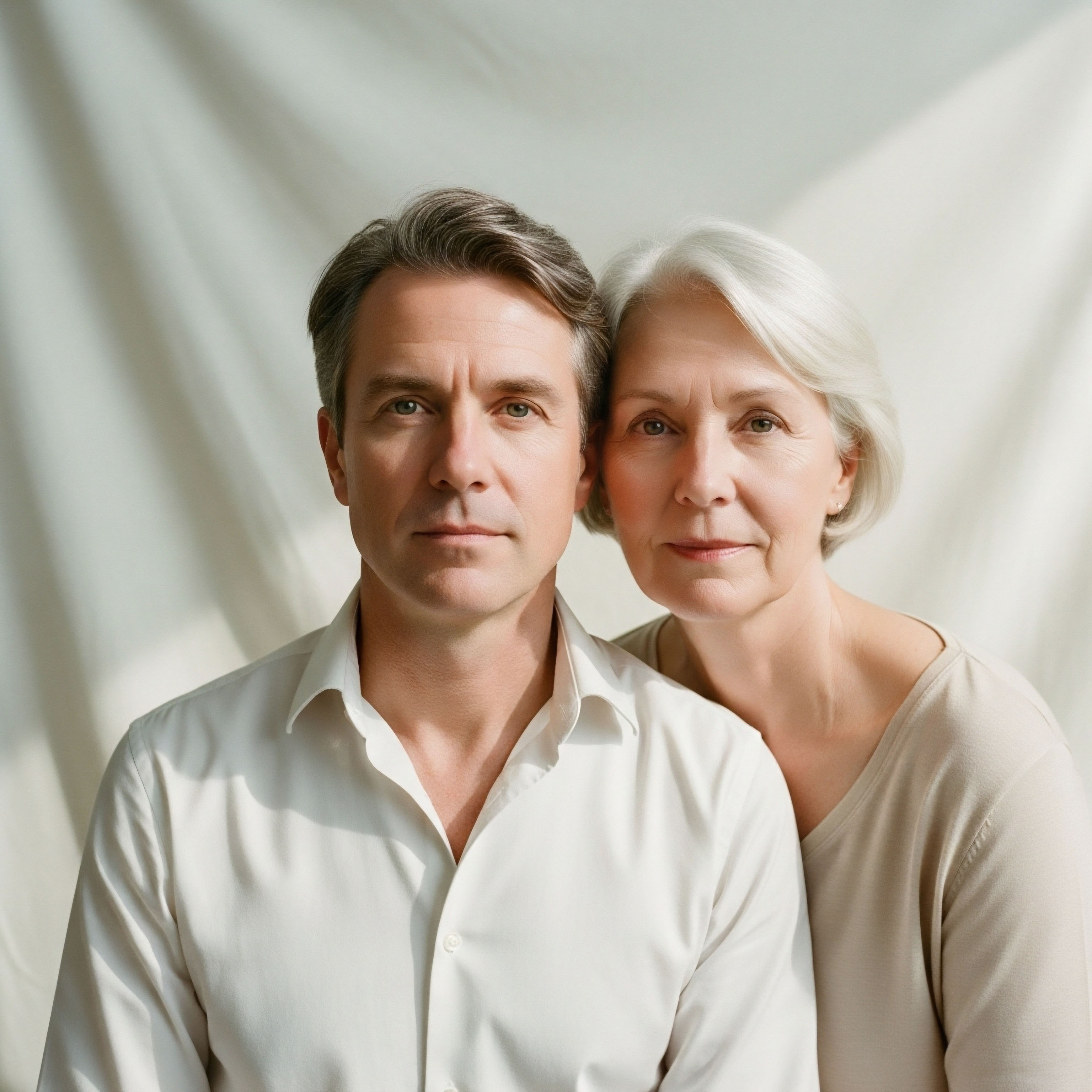

Fundamentals
You feel it long before a lab report gives it a name. It’s the pervasive fatigue that sleep doesn’t touch, the mental fog that clouds your thinking, or the subtle but persistent shift in your body’s resilience. These sensations are your body’s native language, communicating a change deep within its intricate operating system.
When you begin a hormonal optimization protocol, you are introducing a powerful set of instructions into this system. The question of whether your daily choices can influence this process is fundamental. The answer is that your lifestyle choices do not merely assist the protocol; they create the entire biological environment in which these new instructions are received, interpreted, and executed.
Your body is a dynamic system, constantly responding to inputs. A therapeutic protocol introduces a specific, potent input, while your nutrition, movement, stress response, and sleep patterns are the continuous, foundational inputs that determine the system’s overall readiness and capacity to change.
Understanding this relationship begins with appreciating the nature of hormones themselves. They are chemical messengers, produced in one part of the body to deliver a signal to another. Testosterone, for instance, is produced in the testes or ovaries and travels through the bloodstream to act on cells in muscle, bone, and the brain.
For this message to be delivered effectively, the entire communication network must be functional. The message must be sent clearly (hormone production), the delivery route must be open (circulatory health), and the recipient must be ableto hear and act on the message (receptor sensitivity). Lifestyle choices are the primary regulators of this entire communication network.
They are the master conductors of the symphony, ensuring each section plays its part correctly so that the introduction of a new soloist ∞ the hormone protocol ∞ can create a beautiful, coherent result.

The Body’s Internal Communication Axis
Your endocrine system is governed by a sophisticated feedback loop known as the Hypothalamic-Pituitary-Gonadal (HPG) axis. This is the central command line for sex hormone production. The hypothalamus in your brain releases Gonadotropin-Releasing Hormone (GnRH), signaling the pituitary gland to release Luteinizing Hormone (LH) and Follicle-Stimulating Hormone (FSH).
These hormones then travel to the gonads (testes in men, ovaries in women) to stimulate the production of testosterone and estrogen. This is a self-regulating system; when hormone levels are sufficient, they send a signal back to the hypothalamus and pituitary to slow down production.
Age-related hormonal decline occurs as this axis becomes less efficient. The signals may weaken, or the gonads may become less responsive. Hormone protocols are designed to directly supplement the end-product of this axis. However, the axis itself is profoundly influenced by external factors.
Chronic stress, for example, elevates cortisol, which can suppress GnRH production at the source, effectively muting the entire conversation from the very beginning. Similarly, poor nutrition can deprive the body of the raw materials needed to manufacture these hormones, regardless of the signals being sent.
Lifestyle choices directly regulate the body’s core communication networks, determining how hormonal signals are sent, delivered, and received.

When the Message Gets Lost
Imagine sending a critical message in a bottle across a turbulent, polluted sea. The message itself might be perfectly written, but its chances of reaching its destination and being read are low. This is what happens when a hormone protocol meets an unprepared biological environment. Two key factors illustrate this point vividly:
- Insulin Resistance ∞ This metabolic state, often driven by diet and inactivity, creates a condition of cellular “deafness.” High levels of insulin in the bloodstream can interfere with hormonal signaling in several ways. Specifically for men, it can lower levels of Sex Hormone-Binding Globulin (SHBG), a protein that transports testosterone in the blood. This might sound good, as it could mean more “free” testosterone, but the underlying metabolic dysfunction often leads to an overall decrease in total testosterone production, creating a more complex problem. For both men and women, the cellular resistance to insulin is a sign of a broader communication breakdown that can affect how cells respond to all hormonal signals.
- Chronic Inflammation ∞ A state of persistent, low-grade inflammation, often stemming from lifestyle factors like a processed food diet, poor sleep, or chronic stress, acts like static on a phone line. Inflammatory molecules called cytokines can directly interfere with hormone receptors on the surface of cells, making them less sensitive to the hormones circulating in the blood. You could have perfect levels of testosterone or estrogen according to a lab test, but if your cells are too inflamed to recognize them, the intended benefits ∞ improved energy, mood, and body composition ∞ will be blunted.
Therefore, preparing your body for a hormone protocol is an active process. It involves tuning your biological environment to be receptive to the new information you are providing. By addressing these foundational lifestyle elements, you are clearing the communication channels, ensuring the messages sent by your therapeutic protocol are not just delivered, but are heard and acted upon with clarity and precision.


Intermediate
Moving beyond foundational concepts, we can begin to dissect the precise mechanisms through which lifestyle choices modulate the outcomes of specific hormonal protocols. The effectiveness of Testosterone Replacement Therapy (TRT) in men or Hormone Therapy (HT) in women is not a simple matter of dose and frequency.
It is a dynamic interplay between the administered hormone and the body’s metabolic and inflammatory state. Two individuals on identical protocols can have vastly different results, and the differentiating factor is almost always the internal environment sculpted by their daily habits. This environment dictates everything from hormone transport and bioavailability to the sensitivity of the target tissues. Understanding these connections is the key to transforming a standard protocol into a truly personalized and effective therapy.

How Does Metabolic Health Dictate Testosterone Efficacy?
Metabolic health, primarily governed by insulin sensitivity, is a critical regulator of sex hormone balance. In the context of TRT for men, the relationship between insulin, Sex Hormone-Binding Globulin (SHBG), and free testosterone is paramount. SHBG is a protein produced by the liver that binds to sex hormones, rendering them inactive until they are released.
While total testosterone is the overall amount in your blood, free testosterone is the unbound, biologically active portion that can enter cells and exert its effects. Insulin resistance, a condition where cells respond poorly to insulin, leads to chronically elevated insulin levels (hyperinsulinemia). This state directly suppresses the liver’s production of SHBG.
On the surface, lower SHBG might seem to increase free testosterone. However, the reality is more complex. The metabolic dysfunction that causes insulin resistance is often associated with an overall decrease in testosterone production from the testes. This creates a scenario where both total testosterone and SHBG are low, leading to symptoms of hypogonadism even if the free testosterone percentage appears adequate. When a man with underlying insulin resistance begins a TRT protocol, several challenges can arise:
- Aromatization ∞ Adipose (fat) tissue is a primary site of aromatase activity, the enzyme that converts testosterone into estradiol. Individuals with higher body fat and insulin resistance tend to have elevated aromatase activity. Introducing exogenous testosterone can lead to an excessive conversion to estradiol, resulting in side effects like water retention, mood swings, and gynecomastia. This often necessitates higher doses of an aromatase inhibitor like Anastrozole.
- Protocol Instability ∞ The underlying metabolic chaos makes it difficult to achieve stable hormone levels. The body’s own suppressed production and the unpredictable aromatization rates can make dialing in the correct dose of testosterone and ancillary medications a frustrating process of trial and error.
Improving insulin sensitivity through a diet low in processed carbohydrates and refined sugars, combined with regular resistance training, can profoundly alter this landscape. As insulin levels normalize, SHBG production can increase, creating a more stable reservoir of testosterone. Reduced body fat decreases aromatase activity, allowing the administered testosterone to perform its intended function without excessive conversion to estradiol. This makes the protocol more efficient, predictable, and effective, often allowing for lower doses of all medications.
Optimizing insulin sensitivity before and during hormone therapy creates a stable metabolic foundation, enhancing the efficiency and predictability of the protocol.

The Gut Microbiome the Endocrine System’s Hidden Regulator
The trillions of microorganisms residing in your gut are now understood to be a key endocrine organ in their own right. A specific collection of these microbes, known as the estrobolome, produces an enzyme called beta-glucuronidase. This enzyme plays a crucial role in estrogen metabolism.
After the liver processes estrogens for excretion, they are sent to the gut. The beta-glucuronidase produced by the estrobolome can “reactivate” these estrogens, allowing them to be reabsorbed into circulation. An unhealthy gut microbiome, or “dysbiosis,” can lead to an overproduction of this enzyme. This has significant implications for hormone protocols:
- For Women on HT ∞ In post-menopausal women, an overactive estrobolome can lead to an unhealthy recirculation of estrogen metabolites, potentially increasing the risk of estrogen-sensitive conditions. For women on progesterone therapy, balancing the gut is essential for proper hormone processing and elimination.
- For Men on TRT ∞ The management of estradiol is a key component of a successful TRT protocol. If an unhealthy gut is constantly reactivating and reabsorbing estrogen that the body was trying to excrete, it puts additional pressure on aromatase inhibitors like Anastrozole. It creates a situation where you are fighting a battle on two fronts ∞ reducing the conversion of testosterone to estrogen while simultaneously dealing with recirculated estrogen from the gut.
A lifestyle that supports a healthy gut microbiome ∞ rich in fiber from diverse plant sources, fermented foods, and limited in processed ingredients ∞ can help balance the estrobolome. This promotes the healthy excretion of estrogen metabolites, reducing the overall estrogenic load on the body and making hormone management far more straightforward and effective.
The table below outlines how specific lifestyle inputs directly affect the biological mechanisms that underpin hormone protocol effectiveness.
| Lifestyle Factor | Biological Mechanism Affected | Impact on Hormone Protocol |
|---|---|---|
| High-Sugar, Processed Food Diet | Increases insulin resistance; Promotes gut dysbiosis and high beta-glucuronidase activity. | Suppresses SHBG, increases aromatization of testosterone to estradiol, promotes estrogen recirculation, necessitating higher medication doses. |
| Consistent Resistance Training | Improves muscle cell insulin sensitivity; Increases glucose uptake independent of insulin. | Lowers circulating insulin, helps normalize SHBG, reduces aromatization by decreasing body fat, makes testosterone more effective at the cellular level. |
| Chronic High Stress & Poor Sleep | Elevates cortisol levels; Promotes systemic inflammation. | Suppresses the HPG axis, can blunt cellular receptor sensitivity to hormones, counteracts anabolic effects of testosterone and peptides. |
| High-Fiber, Nutrient-Dense Diet | Feeds a diverse gut microbiome; Balances the estrobolome; Provides micronutrients for hormone synthesis. | Promotes healthy excretion of estrogen metabolites, reduces inflammatory load, provides cofactors for optimal protocol function. |


Academic
A sophisticated analysis of hormonal protocol efficacy requires a systems-biology perspective, recognizing that administered therapeutics operate within a complex, interconnected network of physiological signals. The clinical outcome of a protocol, such as Testosterone Replacement Therapy (TRT) or Growth Hormone Peptide Therapy, is not determined solely by the pharmacokinetics of the drug.
It is profoundly modulated by the patient’s background state of metabolic health and inflammation. Specifically, the intertwined pathways of insulin resistance and chronic low-grade inflammation exert a powerful, and often underestimated, regulatory influence on the Hypothalamic-Pituitary-Gonadal (HPG) axis, hepatic protein synthesis, and peripheral tissue sensitivity. Understanding these molecular intersections is essential for optimizing therapeutic strategies and explaining the wide variance in patient response.

The Molecular Crosstalk between Insulin Resistance Inflammation and the HPG Axis
Insulin resistance and its resultant compensatory hyperinsulinemia represent a state of significant metabolic dysregulation that directly impacts steroidogenesis and hormone bioavailability. In men, elevated insulin levels have been shown to exert a direct suppressive effect on the hepatic synthesis of Sex Hormone-Binding Globulin (SHBG).
Research using hepatocyte-like cell lines (HepG2) has demonstrated that insulin downregulates the transcription of the SHBG gene, likely through its interaction with transcription factors such as HNF-4α. This reduction in circulating SHBG alters the ratio of free to bound testosterone. The metabolic syndrome state, however, is also associated with central suppression of the HPG axis.
Pro-inflammatory cytokines, such as Tumor Necrosis Factor-alpha (TNF-α) and Interleukin-6 (IL-6), which are often elevated in states of visceral adiposity and insulin resistance, can inhibit the pulsatile release of Gonadotropin-Releasing Hormone (GnRH) from the hypothalamus.
This leads to attenuated signaling to the pituitary and subsequently, reduced secretion of Luteinizing Hormone (LH), resulting in diminished endogenous testosterone production by the Leydig cells of the testes. Therefore, the patient presents with a dual deficit ∞ impaired central signaling and altered peripheral transport, a complexity that a standard TRT protocol may not fully address without concurrent metabolic intervention.
The interplay of hyperinsulinemia and pro-inflammatory cytokines creates a multi-level suppression of the hormonal axis, from central signaling to peripheral tissue response.

Receptor Sensitivity and Post-Receptor Signaling in an Inflammatory Milieu
Beyond the regulation of hormone levels, the inflammatory state directly modulates the ability of target tissues to respond to hormonal signals. The effectiveness of any hormone, whether endogenous or exogenous, depends on its ability to bind to its cognate receptor and initiate a downstream signaling cascade.
Chronic inflammation can induce a state of “receptor desensitization.” Pro-inflammatory signaling pathways, particularly the NF-κB (nuclear factor kappa-light-chain-enhancer of activated B cells) pathway, can interfere with the transcriptional activity of nuclear receptors like the androgen receptor (AR) and the estrogen receptor (ER).
This molecular crosstalk can lead to a down-regulation of receptor expression or phosphorylation events that inhibit the receptor’s ability to bind to DNA and activate target genes. Consequently, even with supraphysiological levels of a hormone in circulation, the clinical effect may be blunted.
A patient may have a “perfect” lab value for free testosterone but still experience symptoms of fatigue and low libido because the cellular machinery in muscle and brain tissue is refractory to the hormonal signal due to underlying inflammation.
This principle extends directly to Growth Hormone Peptide Therapy. Peptides like Sermorelin and CJC-1295 are GHRH analogs designed to stimulate the pituitary to release endogenous growth hormone. The efficacy of this stimulation is dependent on the pituitary’s sensitivity. High levels of cortisol, the primary stress hormone, can dampen the pituitary’s response to GHRH.
A lifestyle characterized by chronic stress and poor sleep hygiene maintains a high cortisol state, directly antagonizing the intended effect of the peptide protocol. Furthermore, the downstream effects of Growth Hormone are mediated by Insulin-Like Growth Factor 1 (IGF-1), which shares signaling pathways with insulin.
A state of systemic insulin resistance can impair cellular responsiveness to IGF-1, limiting the anabolic and lipolytic benefits of the therapy. Thus, a patient seeking enhanced recovery and body composition changes from peptide therapy will see diminished returns if their metabolic and stress pathways are dysregulated.

What Is the Clinical Application for Protocol Optimization?
A progressive clinical approach must view lifestyle modification as a prerequisite and ongoing component of any hormonal or peptide protocol. The goal is to shift the patient’s internal biochemistry from a state of resistance and inflammation to one of sensitivity and resolution. This involves specific, targeted interventions:
- Nutritional Ketosis or Carbohydrate Restriction ∞ To directly target hyperinsulinemia. By reducing the primary driver of high insulin, these dietary strategies can improve hepatic SHBG production and restore cellular insulin sensitivity, which may also improve IGF-1 signaling.
- Targeted Anti-Inflammatory Diet ∞ Emphasizing omega-3 fatty acids, polyphenols, and high-fiber vegetables to modulate the gut microbiome and reduce the production of pro-inflammatory cytokines like TNF-α and IL-6. This helps to restore receptor sensitivity in peripheral tissues.
- Stress Modulation and Sleep Hygiene ∞ To lower chronic cortisol exposure. This is critical for restoring the sensitivity of the HPG axis and ensuring the pituitary is responsive to GHRH-based peptide therapies. Techniques like meditation, breathwork, and strict sleep schedules are direct physiological interventions.
The following table provides a detailed academic comparison of two patient archetypes on an identical TRT protocol, illustrating the profound impact of the underlying biological environment.
| Biochemical Parameter | Patient A ∞ Insulin Resistant, High Inflammation | Patient B ∞ Insulin Sensitive, Low Inflammation |
|---|---|---|
| HPG Axis Function | Suppressed GnRH pulsatility due to elevated cytokines. Low endogenous LH and testosterone production. | Normal GnRH pulsatility. Healthy baseline LH and testosterone production, providing a better foundation for the protocol. |
| Hepatic SHBG Synthesis | Directly suppressed by hyperinsulinemia, leading to low circulating SHBG levels. | Normal hepatic synthesis, leading to optimal SHBG levels for stable hormone transport. |
| Aromatase Activity | High activity in visceral adipose tissue, leading to significant conversion of exogenous testosterone to estradiol. | Low activity due to lower body fat, minimizing estradiol conversion and related side effects. |
| Androgen Receptor Sensitivity | Blunted by inflammatory cytokine interference (e.g. NF-κB pathway crosstalk), leading to diminished clinical response. | High sensitivity, allowing for a robust clinical response to free testosterone at the target tissue. |
| Clinical Outcome on TRT | Requires higher doses of testosterone and anastrozole; experiences protocol instability and suboptimal symptom relief. | Responds well to a standard dose; achieves stable levels with minimal ancillary medication and reports significant symptom improvement. |

References
- Plottel, C. S. & Blaser, M. J. “The Estrobolome ∞ A New Frontier in Understanding the Gut-Hormone Connection.” Journal of Clinical Endocrinology & Metabolism, vol. 96, no. 8, 2011, pp. 2419-2420.
- Kelly, D. M. & Jones, T. H. “Testosterone and obesity.” Obesity Reviews, vol. 16, no. 7, 2015, pp. 581-606.
- Selvin, E. et al. “The burden of diabetes and hyperglycemia in U.S. adults.” Annals of Internal Medicine, vol. 150, no. 4, 2009, pp. 225-232.
- Pugeat, M. et al. “Sex hormone-binding globulin (SHBG) ∞ from basic research to clinical applications.” Journal of Clinical Endocrinology & Metabolism, vol. 95, no. 5, 2010, pp. 2023-2036.
- Traish, A. M. et al. “The dark side of testosterone deficiency ∞ III. Cardiovascular disease.” Journal of Andrology, vol. 30, no. 5, 2009, pp. 477-494.

Reflection
The information presented here provides a map of the intricate biological landscape within you. It details the pathways, the messengers, and the gatekeepers that govern your vitality. This knowledge serves a distinct purpose ∞ to move you from a position of experiencing symptoms to a position of understanding the systems that create them.
The protocols discussed are powerful tools, capable of initiating profound change. Yet, the most potent tool remains your own informed action. The journey toward reclaiming your health is not about finding a magic bullet, but about meticulously preparing the ground so that the seeds of therapy can flourish.
What part of your internal environment ∞ your metabolic health, your inflammatory status, your stress response ∞ is calling for attention first? The answer to this question is the starting point of a truly personalized path, one that places your daily choices at the center of your own biological destiny.

Glossary

lifestyle choices

receptor sensitivity

hormone protocol

cortisol

sex hormone-binding globulin

testosterone production

chronic inflammation

testosterone replacement therapy

insulin sensitivity

free testosterone

insulin resistance

trt protocol

aromatase activity

anastrozole

the estrobolome

gut microbiome

estrobolome

hormone protocol effectiveness

growth hormone peptide therapy

metabolic health

hpg axis

peptide therapy




